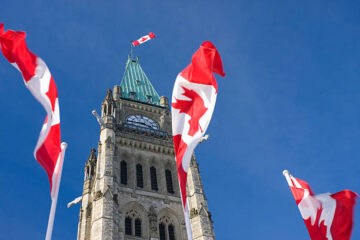The Federal Reserve is stuck in a bind this year, and it isn’t getting any easier.
The Fed’s dual mandate of low inflation and employment is more at odds than usual, and risks of tariffs fueling inflation as job growth slows have left Fed Chairman Jerome Powell on the sidelines waiting for clarity.
Related: Iconic fund manager sends shocking 3-word message on stocks
The Fed’s hesitation to cut interest rates this year has drawn the ire of President Trump, who views rate cuts as central to offsetting the economic pressure caused by his tariff plans.
As a result, Trump and Powell have been in a monetary policy tussle, with Powell recommending patience and Trump advocating urgency.
President Donald Trump has taken aim at the Federal Reserve’s monetary policy this year.
Image source: Win McNamee/Getty Images
The US economy is weakening, and tariff plans could make matters worse
Last November, the President rode to victory on a pledge to curb inflation, reduce taxes, and resurrect U.S. manufacturing.
In his first 100 days, Trump has made moves to reduce the deficit via the Department of Government Efficiency, or DOGE. His administration has hinted at a tax bill that extends the 2017 tax cuts and tackles taxes on tips, overtime, and Social Security.
Related: Billionaire Bill Ackman sends hard-nosed message on China, U.S. trade war
Those moves, however, have been dwarfed by his tariff scheme. So far, he’s instituted 25% tariffs on Canada, Mexico, and autos. He’s also slapped a 145% import tax on Chinese imports and a broad-based 10% baseline tariff on all imports.
Those moves have shaken markets, as tariffs can be viewed as a consumption tax that increases inflation and reduces spending, denting economic activity.
Tariff proponents argue that they’re the best way to strongarm companies to invest in U.S. factories, while also generating revenue that can be used to offset potential tax cuts. Opponents see tariffs as a risky gambit that historically has hurt, rather than helped, the U.S. economy.
Since Trump announced his tariffs on April 2, the worry of stagflation, a period of stagnant economic growth and rising prices, has risen. There’s also been increased concern that we could be heading headlong into a recession.
While unemployment is historically low, it has increased to 4.2% from 3.4% in 2023. In April, companies laid off 105,400 workers, 63% more than one year ago, and the highest for April since Covid forced lockdowns, according to Challenger, Gray, & Christmas.
At the same time, inflation progress has slowed since dropping significantly from 8% in 2022. CPI inflation was 2.4% in March, unchanged from last September, according to the Bureau of Labor Statistics.
President Trump demands Fed interest rate cuts
The cracks in the economic armor aren’t likely to go unnoticed by President Trump’s administration.
The Fed’s monetary policy is a crucial lever to economic activity; however, the Federal Reserve, not politicians, controls decisions on the direction of interest rates.
Related: Wall Street veteran analyst revamps stock market forecast after rally
The Fed Funds Rate influences the interest charged on everything from credit cards to mortgages, and its impact on Treasury bond yields is critical to decisions regarding corporate spending plans (and stock market performance).
Last fall, Jerome Powell cut interest rates in September, November, and December, helping to fuel the stock market and household and business spending to support the jobs market. However, it was forced to pause cuts this year due to inflation risks.
The pause is problematic because the prospect of cuts could go a long way to shoring up consumer and business confidence, a key leading economic indicator.
Consumer confidence has fallen sharply this year, and accelerated in April because of tariffs. A reading below 80 on the Conference Board’s Consumer Confidence Expectations Index suggests a looming recession. That measure collapsed to 54.4 last month, the lowest reading since October 2011.
More Economic Analysis:
Fed inflation gauge sets up stagflation risks as tariff policies biteU.S. recession risk leaps as GDP shrinksLike it or not, the bond market rules all
The data suggests the U.S. economy is at a critical point, and perhaps, unsurprisingly, President Trump’s rhetoric on interest rates has intensified.
Last month, he called Powell “Mr. Too-Late,” a dig at Powell’s incorrect labeling of inflation in 2021 as transitory.
“With these costs trending so nicely downward, just what I predicted they would do, there can almost be no inflation, but there can be a SLOWING of the economy unless Mr. Too Late, a major loser, lowers interest rates, NOW,” wrote Trump on his social media site, Truth Social.
The sharp rebuke led to increased concern that Trump may destabilize the Fed by attempting to remove Powell, despite the Fed’s independence. He has since dialed back his public displeasure with Fed policy, avoiding Powell’s name directly, but he remains highly critical.
On May 2, Trump returned to social media, blasting the Fed to take action following a jobs report showing unemployment didn’t worsen in April. According to the BLS, the U.S. economy created 177,000 new jobs last month. That number shocked Wall Street, which had forecast 138,000 jobs.
A stable jobs market could provide the cover for the Fed to cut rates, potentially softening the blow caused by tariffs. The data prompted a blunt message from the President.
“NO INFLATION, THE FED SHOULD LOWER ITS RATE!!!,” wrote Trump on Truth Social.
Related: Veteran fund manager unveils eye-popping S&P 500 forecast


